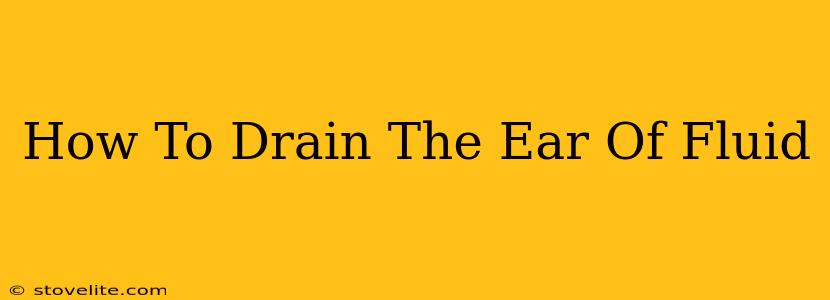Experiencing fluid buildup in your ear can be incredibly uncomfortable, leading to a muffled hearing sensation, pain, and even dizziness. While this condition, often called otitis media with effusion (OME) or serous otitis media, can resolve on its own, knowing how to address it effectively is crucial. This guide provides a comprehensive overview of methods to help drain ear fluid, emphasizing when to seek professional medical attention.
Understanding Ear Fluid Buildup
Before exploring drainage methods, it's essential to understand the root cause. Fluid in the middle ear typically results from inflammation or infection, often following a cold, allergies, or an ear infection. This inflammation blocks the Eustachian tube, the small passage connecting the middle ear to the back of the throat. This blockage prevents the normal drainage of fluid, leading to its accumulation.
Symptoms of Ear Fluid Buildup
Recognizing the symptoms is the first step. Common signs include:
- Hearing loss: A feeling of fullness or muffled hearing.
- Ear pain: Can range from mild discomfort to severe pain.
- Ear pressure: A sensation of pressure or fullness in the ear.
- Dizziness: In some cases, fluid buildup can cause dizziness or vertigo.
- Popping sounds: You might hear popping sounds in your ear as the fluid moves.
- Tinnitus: Ringing or buzzing in the ear.
Home Remedies to Promote Drainage
While you cannot directly drain ear fluid at home without medical intervention, certain home remedies can help alleviate symptoms and promote natural drainage:
1. Saline Nasal Spray or Rinse:
Using a saline nasal spray or rinse can help clear congestion and open the Eustachian tubes, potentially assisting in fluid drainage. This is because a blocked Eustachian tube is often the underlying cause of the fluid buildup.
2. Steam Inhalation:
Inhaling steam can help loosen mucus and alleviate congestion, potentially improving Eustachian tube function. Simply breathe in the steam from a bowl of hot water (be cautious of burns!).
3. Hydration:
Drinking plenty of fluids, especially water, thins mucus and can facilitate drainage.
4. Over-the-Counter Pain Relief:
Over-the-counter pain relievers like acetaminophen (Tylenol) or ibuprofen (Advil, Motrin) can help manage ear pain and discomfort associated with fluid buildup. Always follow dosage instructions.
When to See a Doctor
While home remedies can offer temporary relief, it's crucial to seek medical attention if:
- Symptoms persist for more than a few days.
- You experience severe ear pain.
- You have a high fever.
- You notice drainage from your ear. (This could indicate an infection)
- You experience significant hearing loss.
- You have dizziness or vertigo.
Your doctor may perform a physical examination, including an otoscopic examination to visualize the eardrum. They may also recommend further tests, such as tympanometry, to assess the condition of the middle ear.
Medical Treatments for Ear Fluid
Depending on the cause and severity of the fluid buildup, your doctor may recommend various treatments, including:
- Watchful waiting: For mild cases, your doctor may recommend monitoring the condition and waiting for it to resolve naturally.
- Decongestants: Oral or nasal decongestants can help open the Eustachachian tubes.
- Antibiotics: If an infection is present, antibiotics may be prescribed.
- Ear tubes (myringotomy): In more persistent or severe cases, your doctor may recommend placing small tubes in the eardrum to allow fluid to drain and prevent future buildup. This is a minor surgical procedure.
Important Disclaimer: This information is for general knowledge and does not constitute medical advice. Always consult a healthcare professional for diagnosis and treatment of any medical condition. Never attempt to drain ear fluid yourself; this can lead to serious complications.

